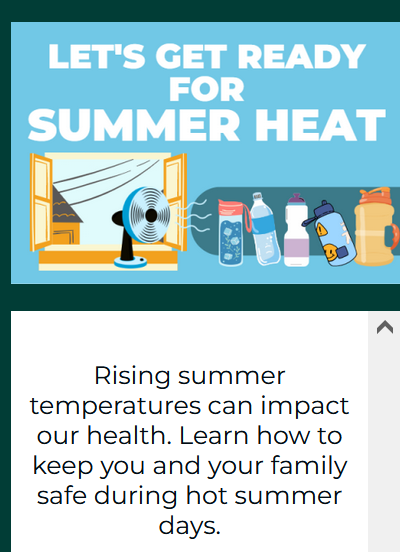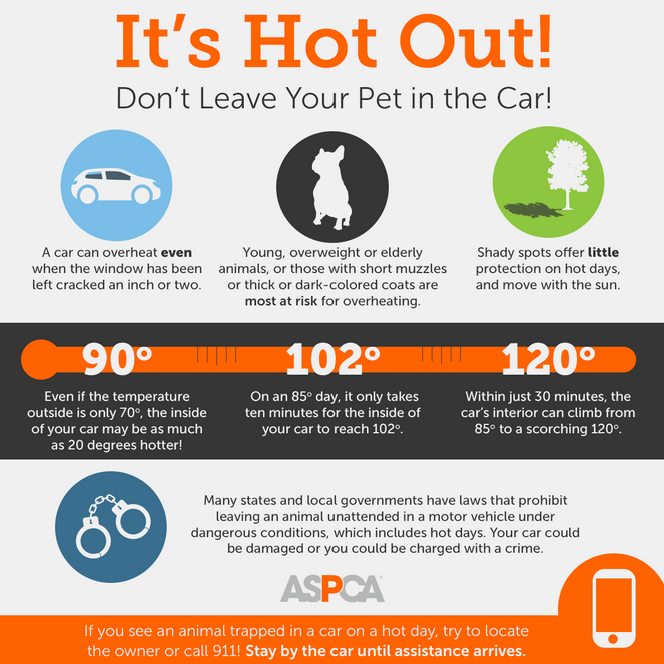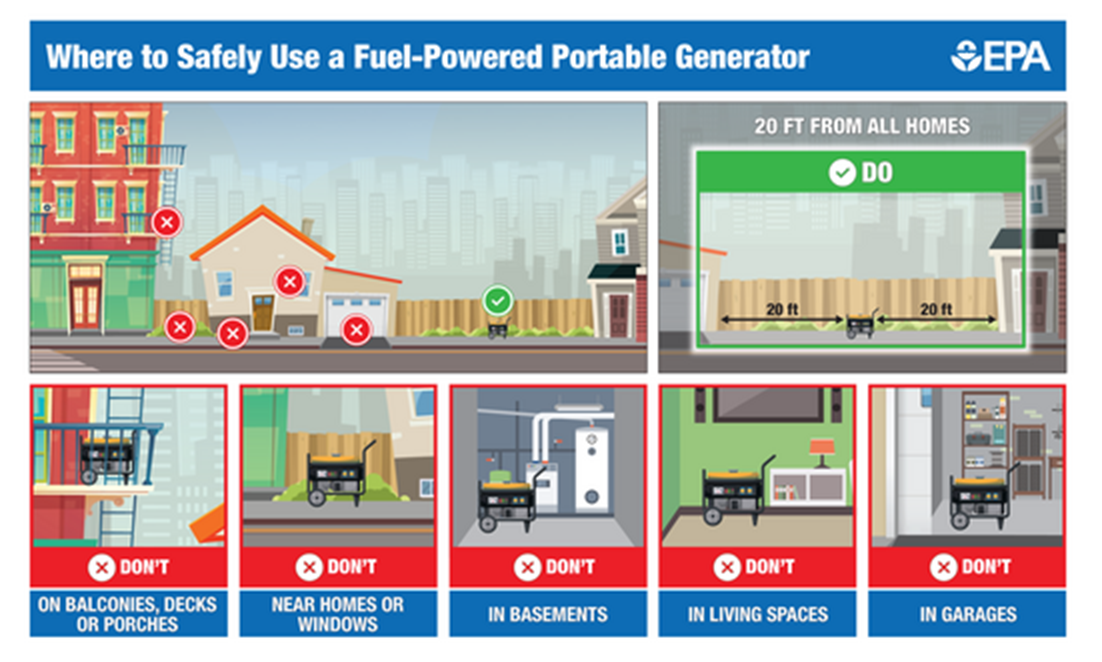Hot weather can lead to heat-related deaths and illnesses - conditions that are preventable. Hundreds of people in the United States die because of extreme heat conditions every year. Know the signs and symptoms of heat-related illness and learn how to protect yourself and those around you from extreme heat.
Share this information with people who may not see it or who need help understanding it.
Place to Stay Cool in Erie County
When the heat rises, there are many places to go to cool down! Find a list of places to stay cool in Erie County at erie.gov/staycool.
Related: Summer Health and Safety for Kids

What is Extreme Heat?
Extreme heat is defined as temperatures that are much hotter and/or humid than average. Because some places are hotter than others, this depends on what’s considered average for a particular location at that time of year. Humid and muggy conditions can make it seem hotter than it really is.
What Causes Heat-Related Illness?
Heat-related illnesses, like heat exhaustion or heat stroke, happen when the body is not able to properly cool itself. While the body normally cools itself by sweating, during extreme heat, this might not be enough. In these cases, a person’s body temperature rises faster than it can cool itself down. This can cause damage to the brain and other vital organs.
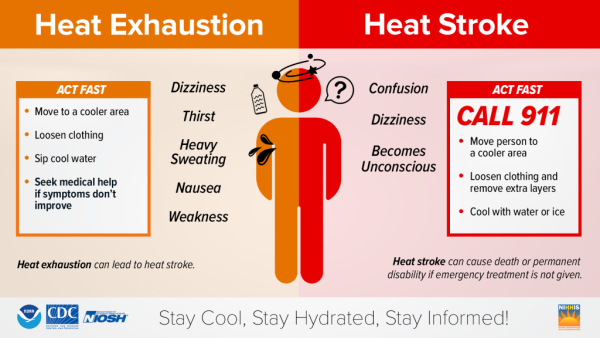
Heat-related illnesses, like heat exhaustion or heat stroke, happen when the body is not able to properly cool itself
Some factors that might increase your risk of developing a heat-related illness include:
- High levels of humidity
- Obesity
- Fever and general illness
- Dehydration
- Prescription drug use and unregulated drug use
- Heart disease, other chronic diseases
- Mental illness
- Poor circulation
- Sunburn
- Alcohol use
Related: Heat Stroke vs. Stroke from the American Stroke Association/American Heart Association
Heat-Related Illness - Emergency Action Steps
Heatstroke
- Move the person to a cool or shady place
- Call emergency services (911)
- Place cold wet cloths on head and neck
- Cool the person off with a cool shower or garden hose
- Do not give the person fluids to drink
- Loosen clothing and remove layers
Heat Exhaustion
- Move the person to a cool or shady place
- Loosen clothing and remove layers
- Sip on water
- Take a cool shower
- Rest lying down
- Call 9-1-1 and get medical help if symptoms do not improve
Who is Most at Risk?
Older adults, infants and young children, pregnant people, and people with mental illness and chronic diseases are at highest risk of heat-related illness. However, even young and healthy people can be affected if they participate in strenuous physical activities during hot weather.
Seniors
Low Income
- If someone's health or safety is at risk, call 9-1-1.
- 2-1-1 is a free, confidential hotline that can provide information about cooling centers and other basic needs.
- Free Air Conditioner - call 1-800-342-3009 to find out if you are eligible to receive one through a Home Energy Assistance Program (HEAP) Cooling Assistance Benefit Program
- WNY Coalition for the Homeless
- Homeless Alliance of WNY
Pregnant People
Mental Health Conditions
- Heat and Mental Health (Anxiety and Depression Association of America)
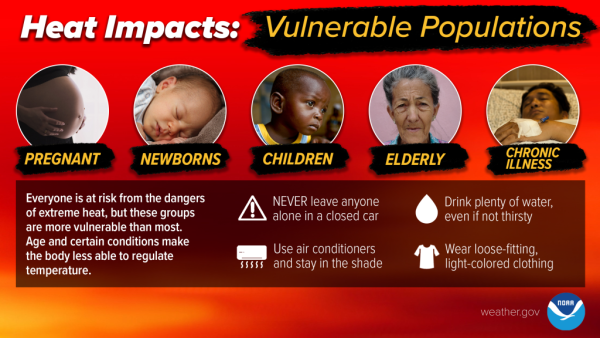
Infants and Children
DON'T EVER leave infants or children alone in a car, even if the windows are cracked open. If you see a child in a hot car, call 911 immediately.
See Estimated Vehicle Interior Air Temperature v. Elapsed Time, which shows how quickly the temperature inside your car rises.
Outdoor Workers
- Heat and Outdoor Workers (CDC)
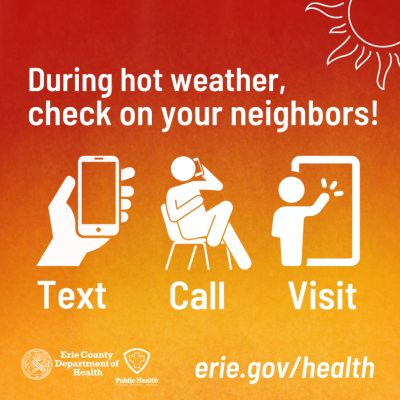
Pets
The high activity levels of dogs, in particular, make them incredibly vulnerable to the heat.
DON'T EVER leave your pet alone in a car, even if the windows are cracked open. If you see a pet in a hot car, call 911 immediately. See Estimated Vehicle Interior Air Temperature v. Elapsed Time, which shows how quickly the temperature inside your car rises.
Here are some tips for keeping your dog safe in the sun:
Learn the signs of heat exhaustion. Excessive panting, a dark purple-red tongue, and redness around the eyes are all signs that a dog may need a serious cool-down. Short-nosed dogs like boxers, bulldogs, and French bulldogs are most vulnerable.
Walk earlier and shorter. Go out before and after the peak heat of the day, and avoid too-hot pavement. Stylish booties to protect paws are a great option.
Be generous with water. A pet's drinking water should be supplied in plastic bowls that don’t trap the heat and that are constantly available during outside exercise or play. Consider setting up kiddie pools or sprinklers for dogs to run around in. The easier it is for them to access a way to cool down without your help, the better.
- Hot Weather Safety Tips for your Pets
- Contact your veterinarian for questions about your pet's health and safety.
If the Power Goes Out
If you need temporary power to provide cooling or refrigeration, be sure that portable generators are placed outside and at least 20 feet from any doors or windows. Exhaust from portable generators contains deadly carbon monoxide.
Be sure that portable generators are placed outside and at least 20 feet from any doors or windows
Heat and Health Data
- Heat Stress: Explore data on the percent of heat stress hospitalizations and emergency department visits in NY State due to heat.
- County Heat and Health Profiles help identify populations and neighborhoods at highest risk and help communities prepare for and prevent heat-related illnesses.
- Heat Vulnerability Index Maps identify areas in the state where people are vulnerable to heat. Heat vulnerability is how likely a person is to be injured or harmed during periods of hot weather.
- NYSDOH:
- Erie County Heat Vulnerability
- Heat Risk and Illness Dashboard
- Climate Change and Health
- Extreme Heat and Health in NY State presents the latest research on extreme heat and impact on health in New York State.
Additional Resources
- Ready Erie App informs and prepares Erie County residents for emergencies. Receive notifications, locate emergency shelters, view up-to-date evacuation maps, create a personalized emergency preparedness plan & more.
- Ready Wrigley provides parents, guardians, teachers, and young children with tips, activities, and a story to help the whole family prepare for emergencies.
- The International Institute of Buffalo offers free "Be Prepared for Summer" flyers, available for download in 11 different languages. Feel free to distribute online or in person to your community!
- Air Quality: Ways to stay safe when air quality goes down
- Erie County Environment & Planning Climate Action and Sustainability
- National Weather Service Heat Index
- Climate Change and Extreme Heat: What You Can Do to Prepare
